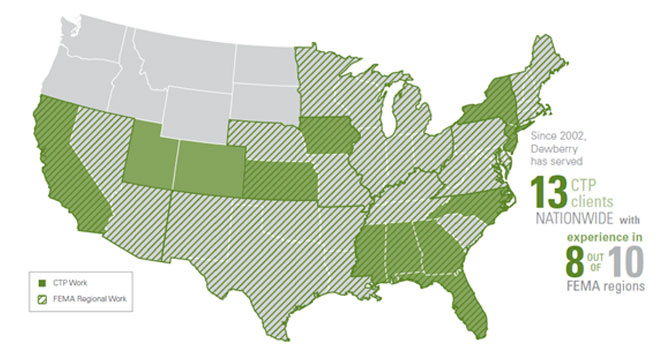In the peak of hurricane season, flooding becomes a concern in many communities throughout the country, just as we recently experienced with Hurricane Joaquin that brought major flooding to the southeast. We believe one of the best ways to protect a community from a similar event is to increase awareness about the threat flooding may pose to their community. One of the best opportunities we have to work closely with communities on flood risk awareness is through the Federal Emergency Management Agency (FEMA)’s Cooperating Technical Partner (CTP) program.
Back in 1999, we started working with FEMA alongside states and local communities to develop a new process called the CTP program that would give local and state partners the ability to administer FEMA driven flood study projects for their respective jurisdiction. This was a revolutionary change by FEMA from the traditional process of creating flood insurance studies. Founding the CTP program enabled greater local input and attention to the process and as a result, state and local partners have taken more ownership over the identification and dissemination of their flood study information.

This CTP map shows the probability of inundation of flood zones, a key tool for assessing risk.
The Value of Local Partners
Local partners are very valuable to FEMA for many reasons, but probably the most vital is the individualized attention they can offer their communities and their ability to customize information and tools that better serve their unique needs. This has led many CTP programs to establish robust community engagement plans, ensuring they are taking every opportunity to meet with communities throughout the project life-cycle and are including targeted and consistent messaging. Increased community engagement led by CTP programs have helped to increase buy-in and support for the new flood studies, which have significantly reduced unnecessary and time-consuming challenges in the adoption of the maps.
We have helped CTP programs craft their community engagement plans to be scalable and customizable since not all projects and affected communities are equal in size, capabilities, or risk. This offers flexibility to CTP programs, allowing them to focus their attention and resources where their biggest outreach needs exist. CTP programs are often ambitious in their mission to create safer, more flood-resilient communities, which make them one of the best conduits of innovation within FEMA’s Risk MAP program. Some examples of CTP-driven innovations include:
- Automated processes to notify individual property or business owners of a change in their flood risk
- Integrating dam break studies into the risk assessment process
- Developing parcel and building-specific flood risk profiles
- Introducing advanced unsteady and 2-D flood modeling
- Creation of user-friendly websites that provide the public with educational materials and individualized flood risk information.
CTP Mitigation Actions
Another area with great potential for leadership and innovation by CTPs is maximizing ways to mitigate flood risk. Mitigation actions can take many forms, and some examples of those include:
- Flood forecasting and warning systems
- Adoption of higher standards
- Partnership with transportation or public works agencies for capital improvements of road crossings
- Dam rehabilitation and spillway improvement
- Targeted property acquisition informed by building specific flood risk
In helping to drive innovation with CTP programs, Dewberry’s philosophy is to deliver customized solutions that meet the specific mission and priorities of the CTP, while adhering to the standards and goals that FEMA expects. We have seen firsthand how property owners and stakeholders in every type of community across the country can benefit from the locally driven brand of Risk MAP that the CTP program affords.

The Benefits of Becoming a CTP
In order to take advantage of the opportunities the CTP program provides you must first become a CTP by following the three simple steps given below. Other benefits of becoming a CTP include:
- Capitalizing on existing project data funded and developed within the CTP jurisdiction
- Securing additional program activities such as Letter of Map Revision (LOMR) work
- Greater control of project pace and the schedule of FIRM release
- Direct input in the flood study modeling, process, and product roll-out
- Ownership of flood study results and how the FIRM will appear
- Ability to customize messaging to meet the needs of the your program and your communities
- Greater potential to generate products that could be used to support other types of grant program initiatives
- Eligibility for additional credits for your communities participating in the Community Rating System

Increasing State and Local Partnerships
We hope that by explaining the benefits and possibilities of the CTP program that more state and local entities will see the value of partnering with FEMA and becoming a major player in the fight to address our nation’s flood risk and form a more resilient society. We look forward to continuing our work with communities across the U.S. and hope to provide support to more local entities interested in pursuing CTP status.
Resources for Your Community
For more specific information about the specifics of the CTP program, please review our brochure.
For more information from FEMA about the CTP program, please visit: